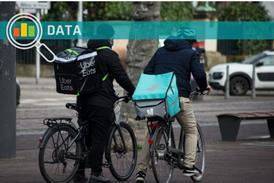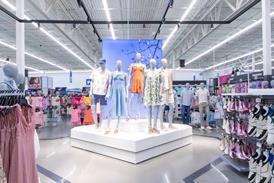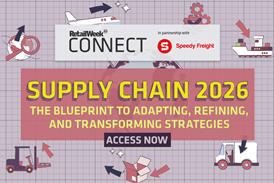Drowning in data?
Learn from Tesco, The Very Group and others about how to connect, harness and scale up

Retail businesses having one holistic view of all data was once seen as an unreachable holy grail. Not anymore. New technologies are enabling meaningful and scalable data strategies.
From email opening rates and dwell time stats to footfall figures and real-time stock data, there is a number for every aspect of the retail machine. This plethora of statistics can provide decision makers with seemingly never-ending data points to better inform their strategies – whether for demand forecasting, shipping management, marketing campaigns or product trends.
But for some retailers, the gravity and scale of data collection, governance and management are almost insurmountable, and many need to reassess their strategies to ensure they are getting the most from the data they have. That it is accurate and the right people are getting access at the right time, while also adhering to compliance and security.
This Retail Week deep dive, produced in partnership with Adverity, examines the challenges and opportunities data presents as we look at the ways you can keep on top of it all.
Contents
1. The data dilemma
If knowledge is power, then it follows that the more a company knows about its customers and their behaviour, the more insight it has into its supply chain, and the more advanced intelligence it has on various factors driving the market from the weather to pricing, then the more empowered it will be. Accurate and well-managed data is also the essential foundation of any AI strategy – a tool most businesses are eyeing to futureproof their enterprise.
But that doesn’t mean that data, in all its vastness and complexity, isn’t daunting. Faced with gathering, storing, understanding, and knowing how and when to act on data, smaller retailers might well ask how they are expected to find the people-power, or the money, to develop a fully functioning data arm on top of what they are already doing. Especially when bigger competitors, or digital-first businesses, seem to have the whole problem sewn up already, at least on the surface.
On the flip side, for large companies, millions of data points are generated every day. They’re faced with the monumental task of implementing the right data strategy without alienating colleagues or falling behind competitors that are also racing to get their businesses up to speed.
All companies share some of the same data concerns. Security – the responsibility to manage data without risk of breaches, especially personally identifiable information (PII) – has to be a top priority. Compliance with local and international law also adds layers of complexity, particularly when those rules are in a constant state of evolution.
Retailers large and small want to make sure their approach to data is accurate. How to store large datasets, at one end of the spectrum, and how to visualise and help people understand its nuances, at the other, are overarching concerns.
But those that manage to create a holistic view of their business performance by combining disparate datasets and use it to inform future decisions across their business are the ones that will thrive.
The good news is that the retail industry appears to be edging forward in its data proficiency and as a follow-on, AI strategies are starting to accelerate.
This was illustrated by recent Retail Week research, which interviewed 43 UK retail leaders across 39 businesses about their strategies for 2025. On the topic of AI, we asked them to rate themselves from one (not using AI) to 10 (widespread use of AI across multiple business areas). We found that 23% of retailers rated themselves between six and eight. Just 13%, five out of the 39, said they were not using AI. Even then, closer inspection found some of them were using it in limited forms.
2. What data are we talking about?
Data is an unwieldy, catch-all term. Everything, arguably, is data (and, if you’re an AI, literally so).
Let’s break it down into some of the specific kinds of data most relevant to retail businesses.
One key branch of data might be covered by the umbrella term “marketing”, for example, and include what customers have bought in the past, what pages they have dwelled on, where they live, their age, whether they have children, their income bracket and other details.
Alongside the wealth of customer data that many retailers hold, marketing campaign data provides a whole other level of figures that can hold the key to subsequent success.
From data on clicks, spend and reach to figures on ad performance, ROI and traffic, retailers have an abundance of data that can help establish how historical marketing campaigns have performed and, in turn, shape future campaigns.
This information, combined with all company data, from logistics to inventory, enables firms to build a holistic view of what is happening, what is working and what isn't.
“When it comes to data, there is no reason to restrict yourself to just marketing data or just sales data,” explains Mitesh Lakhani, senior director of solutions consulting at Adverity. “It’s when you start combining these different data sets that you start to get the kind of juicy insights that can really help your business succeed.”
When it comes to customer experience, useful data might include details about what their delivery or returns experience has been like, whether they enjoy shopping in-person or online, and how they interact with email, chatbots and other forms of brand communication.
This can help retailers to create a more personalised online or in-store experience. Those same details might be useful for the same company or an affiliate to suggest new product lines as part of a business development goal: gym membership offered to a sportswear enthusiast, or baby massage to a buyer of nappies.
Clubcard data has been called the UK's 'largest, most diverse, and most socio-economically representative' dataset (Source: Tesco)
Clubcard data has been called the UK's 'largest, most diverse, and most socio-economically representative' dataset (Source: Tesco)
Retailers across the globe have capitalised on the treasure trove of data now available to make better business decisions.
Walmart is among the firms to be using data to its advantage. The US retail giant uses sales data, weather patterns, local events and social media to predict demand and then perfect its inventory.
Earlier this year, Deliveroo chief operating officer Eric French told Retail Week how the delivery app uses its search data to help inform its strategy when plotting areas to expand into.
Deliveroo, traditionally known for its food offering, has outlined key target retail categories including flowers, gifting, health and beauty, pet care, home and kitchenware, and DIY as a result of harnessing data that highlighted what customers are searching for.
Starbucks uses demographic and footfall information to plot new store locations, while Amazon has built its whole business on data and uses it to personalise recommendations, predict demand and optimise its supply chain.
And examples don’t just come from retail. The Philadelphia 76ers, a US basketball team, combined weather data with marketing and sales data to identify game day attendance patterns.
This helped with its revenue goals and much more, allowing it to predict what food product the organisation would need for the hot dog stand, for example, or how many drinks they should provide.
On a more pure retail, granular level, consumer electronics brand Currys rolled out software in 2022 to help store staff surface customer data at the checkout, which was part of a wider digital transformation programme to manage various parts of its data strategy.
Having a better grasp of data also allows a whole cohort of firms to develop new revenue streams in the form of adjacent, data-led businesses.
In September 2024, The Very Group launched Very Media Group, a venture that allows partners to use the expertise Very has built up in marketing to its customers and people like them. It became the latest in a series of companies to do something similar, including Currys Connected Media and Tesco Media and Insight, powered by Dunnhumby.
Tech firms Samsung, Acer and Hisense are among the brands using the Currys network to engage with consumers. Meanwhile, beverage company Molston Coors and nicotine patch brand Nicorette have partnered with Tesco Media and Insight.
Writing about the science behind that platform in July 2023, Simon Lonsdale, strategy director at Dunnhumby, a data science firm owned by Tesco, explains: “Scale is important… because the larger the audience you have at your disposal, the more likely it is that you can find the distinct groups you need. It's here that the Tesco Clubcard comes into play.”
Because it provides insight into more than 20 million customers from across the UK, Lonsdale says: “The Clubcard serves as the country’s largest, most diverse, and most socio-economically representative first-party behavioural dataset. In short, if you want to know how Britain shops for its groceries today – and learn how to shape what Britain buys tomorrow – then Clubcard data is a very good place to start.”
Other retailers would no doubt argue the same for their customer datasets.
3. The challenge around turning data into insight
We’ve established that wonderfully rich and timely data exists across every aspect of a retail business. However, getting that data into one place is a big part of the challenge.
While no company is 100% data savvy, there are some that are a step ahead and these are the ones with a ‘single source of truth’ – a centralised and single set of clean, consistent data.
Nonetheless, research by Adverity earlier this year found 38% of respondents say their data is stored across multiple platforms, making it difficult to combine and contrast to make meaningful comparisons. The study also found that for almost a third of respondents (32%), a spreadsheet is the most advanced tool they use, meaning many firms are still utilising manual, error-prone methods.
“A growing mountain of data coming from a variety of sources and in different formats is an increasing headache for marketing teams, among other areas of the retail machine,” says Lakhani. “But it is imperative they have a process of collecting and transforming data into a usable, unified format – since that’s the only way to really be able to make data-driven decisions that will have a genuine impact on the business.”
Streamlining data processing can take many guises, but one scalable and time-saving solution is to employ technology that enables data to be regularly delivered, cleaned and made 100% accurate, rather than manually downloading data from multiple sources. This way, retailers can compare like-for-like results with up-to-date insights.
This not only saves many hours of manually copying, pasting, ensuring consistency and then analysing, but also allows no room for human error. Teams can instead use that time making decisions on the results and fine-tuning campaigns, products and improving ROI based on the data provided.
Some companies appear to have a massive advantage, namely those that either started in the digital age or had a history of remote selling via catalogue, with data at their core, which have also achieved enough commercial success to make funding engineers and data scientists relatively easy.
There’s no doubt, though, that businesses of all sizes can get into a pickle when it comes to their data strategies. In 2019, Ikea’s Austria business, despite being part of one of the biggest home furnishing chains in the world, found itself manually managing large amounts of data from various sources via a system of spreadsheets. It had no way to easily integrate or analyse important data from its Family Loyalty programme and its whole approach was fragmented. As a solution, the company utilised Adverity to automate its data collection and bring it all together in a single source of truth.
At your business, what are the main approaches and first steps when it comes to tackling data?
4. Getting on top of the data problem: techniques and tools
A lot of companies had to decide in the last few years how to manage their transformation to become true digital players. It hasn’t always been easy. But analysing some of the strategies they have employed suggests three approaches. These might be used separately or, more likely, in conjunction with one another, to achieve transformation and, crucially, maintain coherence across the whole of a complex business:
Fully in-house: Upskilling existing staff and employing specialists
The upskilling trend arguably kicked off in 2018 when M&S launched what was then called the world’s first retail data academy. The government-funded collaboration with Decoded aimed to train 1,000 employees in data-focused programming languages such as R and Python.
In September 2024, The Very Group announced it was partnering with Multiverse, a tech training company, to train 11 data professionals to degree level via a 39-month course.
“As data has become such an important part of business decision-making, our data teams are in high demand, which can restrict the time spent on more strategic initiatives,” says Rob McCormick, head of data at The Very Group, adding that the training would “increase efficiency and productivity through data and automation”.
A useful comparison can be made here between retail and other industries, including banking and energy. Just as a new player in the retail space might choose to start with more engineers, and create data-led processes from the beginning, so too have new companies in other consumer-facing industries.
Monzo, a challenger bank that launched in 2015 and now has 10 million customers, is transparent with its data strategies and generous in explaining them, publishing numerous blogs about exactly how it does what.
One principle that is worth getting to grips with is the concept of ‘hub and spoke’, used in a couple of different ways to mean techniques whereby data, methodologies or expertise are centralised so that a whole company can benefit from them, rather than work being replicated.
“We encourage our data scientists to spend maybe 30% longer answering a question if it means they do it in a way that's easily reproducible and benefits other people in the company. For example, this could mean adding missing dimensions to existing data models rather than writing ad-hoc queries,” wrote Dimitri Masin, head of data and analytics at Monzo.
Finding technology partners that specialise in data management, and building internal expertise from there
Many retailers use a bespoke third-party service, or more than one, to manage their transformation to becoming data-led retailers. This outsourcing can take several forms. It might involve employing a ‘big name’ consultancy to scope out the problem and suggest specific solutions, as Currys did with Accenture. It might involve employing a company that specialises in data transformation to work on all, or part of one’s business, as Ikea in Austria did with Adverity.
Tools for managing data have proliferated so while the work of a third-party specialist might be to provide software, it might just as easily help a company assemble the right suite of products and processes for its own needs from big names like Microsoft and AWS.
Well-known retailers such as Marks & Spencer have gone down this route as part of a business transformation investing in data analytics and AI.
Tools like Adverity help businesses manage their data but also provide the opportunity for them to upskill their staff at the same time. “Adverity provides the platform for companies to integrate and manage huge volumes of data,” says Lakhani. “But in doing so we want to empower them to be able to take control and make the most of their data.
“We talk to our clients about best practice, about adoption, about how [brands] should be utilising our products in the best way.
“That really gives them not only the platform to get the data but also an idea about where they should go and how to eke out those insights in the future.”
Build or buy a separate company to manage your data for you
Energy, another deeply data-led industry, has also seen some traditional players struggle to adapt, allowing data-first businesses to grow up quickly.
Octopus Energy, tiny in 2016, now powers 7 million homes in the UK and abroad. Part of the secret to its success, says Alex Schoch, global clean tech director at the company, is its under-the-hood tech business. “When people think of Octopus, it’s easy to just think of us as an energy company, but we’re a tech company at heart,” Schoch tells Retail Week.
“Everything we do is underpinned by our tech platform, Kraken, which processes well over 4 billion rows of data every day. It’s our not-so-secret weapon that allows us to better serve customers, balance our changing energy grid and speed up the energy transition.”
Some recent data-led innovations include the company’s Saving Sessions during which customers sign up to a challenge to use less electricity at certain times. If they manage, their account is topped up with commensurate credit. The company is also offering free electricity when the data shows an oversupply of power in the grid.
Buying a company for its expertise is an option that some large retailers and other customer-facing businesses have used, but it's likely only an option open to retailers working at scale. This is the route Tesco went down, using Dunnhumby, a data specialist in which it bought an initial stake back in 2004, to run a lot of its data-related projects.
The solution has allowed Tesco to get its teeth into the data made available through its Clubcard membership scheme, paving the way for a transformation towards a more data-led business and the customer-facing innovations that makes possible, without having to hire or train that expertise in-house.


5. Finding your data path
Tackling data is, of course, a huge and complex problem. But it’s also one that can be broken down into its constituent parts.
Russell Davies, who has headed transformational data projects for companies including Lastminute.com, O2, and British Gas, neatly sums up a way for any company to think about putting a new data strategy in place.
“You need systems to capture the data, and you need processes in place to make sure you keep that data as clean and unpolluted as possible,” Davies tells Retail Week.
Case studies abound of even the most established companies finding ways to transform for the data age.
Very's 'Let’s Make It Sparkle’ Christmas campaign was informed by understanding customer data (Source: The Very Group)
Very's 'Let’s Make It Sparkle’ Christmas campaign was informed by understanding customer data (Source: The Very Group)
“As a business with a rich history of over 100 years, The Very Group has vast experience in responsibly collecting data and using this to inform how we can enhance the customer experience,” Jessica Myers, chief customer officer at The Very Group, tells Retail Week.
“Our business brings together a retail experience with flexible ways to pay, meaning we have unique access to personal, shopping and financial data across our 4.4 million active customers. This enables us to get a deeper understanding of individual shopping behaviours and customer wants, which we can use to enhance the customer journey.
“We are always looking for ways to collect and grow our data to support how we fulfil our purpose. In fact, between June 2023 and January 2024, we increased the number of data points we have on customers by two-thirds, and these insights help to inform decisions in every aspect of the business
“Our rich customer insights drive decisions across the business, but one recent example over the last year was in the optimisation of our own brand marketing. Our ‘Let’s Make It Sparkle’ campaign is rooted in our customer understanding, and the impact is clear: on the back of this campaign, we saw material growth in brand attribution, sentiment and shopper intent.”
For Adverity, the central issue is one of data maturity. Companies today, whether large or small, are often at different stages of progress in how they manage and leverage data. As Lakhani points out: "Even major organisations can find themselves excelling in some areas while falling short in others. One company may have advanced data collection capabilities but lacks a secure infrastructure, while another might have the right tools but lacks a data-driven culture to truly unlock the value of that information."
The key for any organisation is to identify the gaps that are hindering full adoption of data practices. "It’s not just about having the technology," Lakhani adds. "It’s about understanding where your organisation stands and focusing efforts on those areas that need the most attention." Whether through incremental steps or a large-scale transformation.
Looking to the future, Davies pointed out that the big data issue will be processing power. While companies have long stored massive amounts of data relatively cheaply, the advent of AI means that data is now being put to work in a new and much more intensive way, leading to expensive computing power and high energy demands.
But while there will always be challenges around the corner, beginning to connect the data dots now, or progressing to the next stage of the data evolution, is worth the investment today.
Want to find out more about how you can connect, manage and scale your marketing data with ease?























